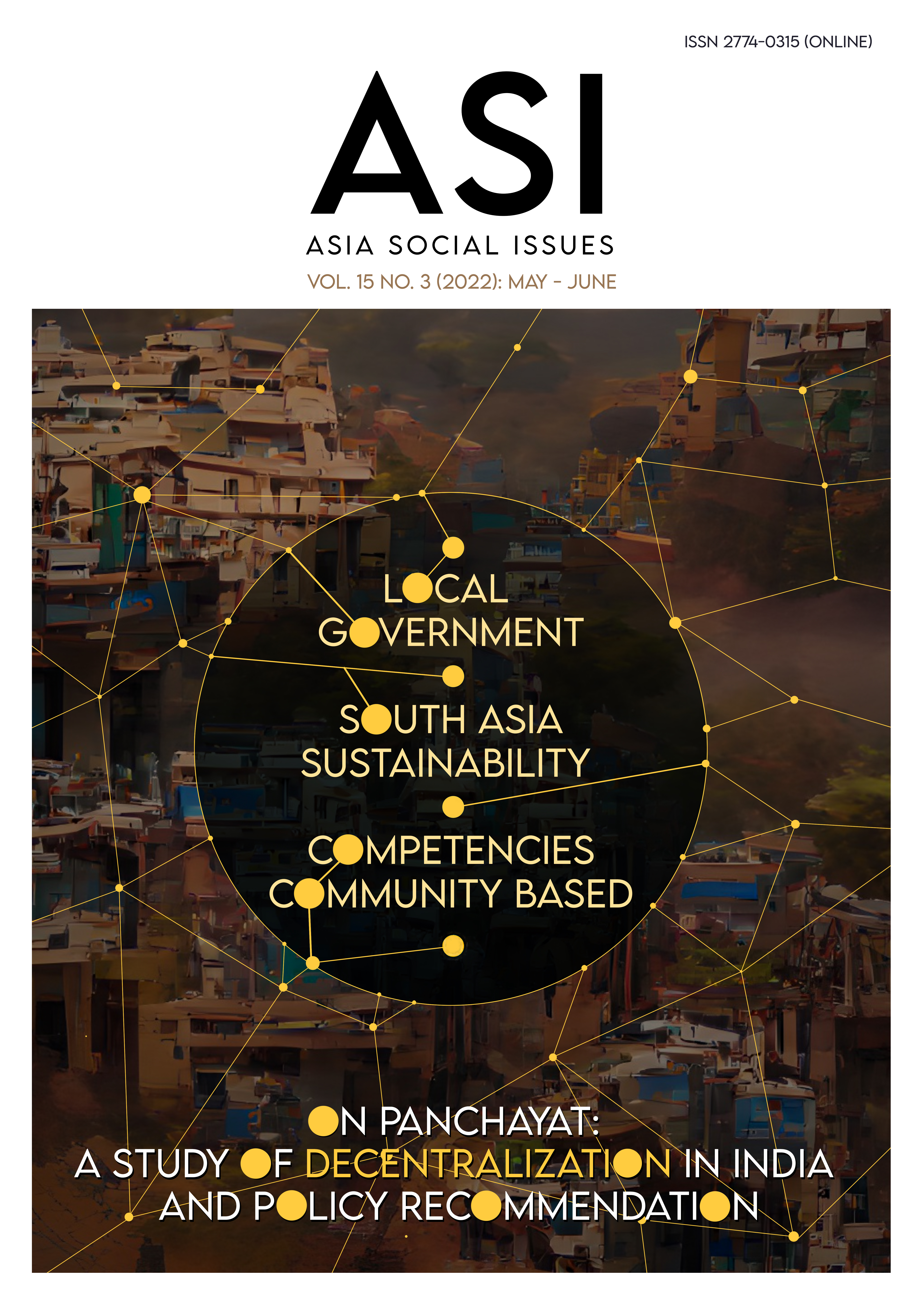On Panchayat: A Study of Decentralization in India and Policy Recommendation
Main Article Content
Abstract
This paper aims to study India’s decentralization process, which focuses on the Panchayat or the village government as a demonstration of success in India’s decentralization. This paper employs documentary research with a systemic review of relevant literature, articles, and documents on India's decentralization policy after independence up to the present (during 1947-2020). This paper found that India emphasizes people participation and decentralization, primarily through the Panchayat, which the constitution has authorized. The Indian government also established the Ministry of Panchayati Raj to facilitate the process of decentralization. The key success of India’s decentralization is related to its financial decentralization that allows the local government to collect tax and financial supports. This research also suggests five recommendations to increase the level of decentralization. First, decentralization must be written in a country’s constitution. Second, decentralization could effectively work with a unitary state with a federal feature. Third, the village is the foundation of decentralization. Fourth, the state should establish or form a ministry or another form of a government body to implement a policy of decentralization. Finally, decentralization must be political, administrative, and financial.
Article Details
Copyright: CC BY-NC-ND 4.0
References
Arora, N. D. (2010). Political science for civil service main examination. New Delhi, India: Tata McGraw-Hill.
Basu, D. D. (2011). Introduction to the constitution of India. Nagpur, India: Lexis Nexis, Butterworths Wadhwa.
Chareonmuang, T. (2001). 100 years Thailand loval goverment BE 2440-2540 (in Thai). Bangkok, Thailand: Foundation for Democracy and Development Studies-FDD.
Cheema, G. S., & Rondinelli , D. A. (1983). Decentralized and development. London, the United Kingdom: Sage.
Chhertri, D. P. (2013). Democratic decentralisation and social inclusion in India: Exploring the linkages. IOSR Journal of Humanities And Social Science, 11(1), 64-72.
Deccan Chronicle. (2017). Kerala: Six villages to be declared old-age friendly. Retrieved from https://www.deccanchronicle.com/nation/in-other-news/290517/kerala-six-villages-to-be-declared-old-age-friendly.html
Gajwani, K. (2005). Decentralization and state-level gains: An emprirical analysis in India (pp. 23-25). In Proceedings of the NEUDC Conference. Rhode, Island: Brown University.
Ghai, K. K. (2021). 73rd and 74th constitution amendments and reservation for women. Retrieved from https://www.yourarticlelibrary.com/constitution/73rd-and-74th-constitution-amendments-and-reservation-for-women/40440
Human Development Resource Center. (2000). Decentralisation in India: Challenges and opportunities. Nee Delhi, India: United Nations Development Programme.
Islam, M. T., & Fujita, K. (2012). Dimension of decentralization process and rural local government in India: A comparison with Bangladesh. Kyoto, Japan: Kyoto Working Papers on Area Studies No 130.
Janda, K. (1980). Political parties: A cross-national survey. New York, The United States of America: The Free Press and Macmillan.
Kalirajan, K., & Otsuka, K. (2010). Decentralizalization in India outcome and opportunities. Canberra, Japan: ASARC Working Paper 2010/14.
Kattakayam, J. (2021). Age friendly village self-governments in Kerala India: An initiative to empower the elderly. Retrieved from https://www.ifa-abstracts.com/age-friendly-village-self-governments-in-kerala-india-an-initiative-to-empower-the-elderly
Khan, M. M. (2009 ). Decentralization in Bangladesh: Myth or reality? Dhaka, Bangladesh: A H Developing Publishing House.
Kumar, V. A. (2012). Administrative decenttralization and development in a complex democracy. Think India Quatery, 11(2), 60-79.
Ministry of Interior. (2021). Executive summary on decentralisation in Thailand (in Thai). Retrieved from http://www.local.moi.go.th/webst/decon.htm
Ministry of Panchayati Raj. (2021). Spatial planning. Retrieved from https://www.panchayat.gov.in/en/web/guest/spatial-planning
Ministry of Panchayati Raj. (2018). MoPR presentation on FC (p. 1-24). In Proceedings of the Conference of State Panchayati Raj Ministers & Chairpersons of State Finance Commissions on Panchayat Finances. Delhi, India: Ministry of Panchayati Raj.
Pennock, R. J., & Smith, D. G. (1964). Political science. New York, The United States of America: McMillan.
Prasad, N. (1955). Gandhian concept of decentralization from Harijan. Retrieved from https://www.mkgandhi.org/articles/concept.htm
Rao, M. G. (2020). Fiscal decentralization in Indian federalism. Retrieved from https://www.imf.org/external/pubs/ft/seminar/2000/fiscal/rao.pdf
Sahoo, N. (2020). Even after 20 years, decentralisation still remains a challenge. Retrieved from https://www.orfonline.org/research/even-after-20-years-decentralisation-still-remains-a-challenge
Sharma, M. L. (1987). Gandhi and democratic decentralisation. New Delhi, India: Deep and Deep Publications.
Sheikh, Y. A. (2014). Democratic decentralisation in India: An overview. International Journal of Social Science & Interdisciplinary Research, 3(7), 196-203.
Shodhganga. (2020). Chapter 2 decentralized government in India: The evolution . Retrieved from http://shodhganga.inflibnet.ac.in/jspui/bitstream/10603/137497/10/10_chapter_02.pdf
Shubhangi, R. (2021). Gandhian concept of village development and Indias development policy. Retrieved from https://www.mkgandhi.org/articles/village_development.html
Tammita-Delgoda, S. (209). The golden age of India (p. 71-91). In Tammita-Delgoda, S. (Ed.). A Traveller’s history of India.Wiltshire, United Kingdom: CPI Antony Rowe.


